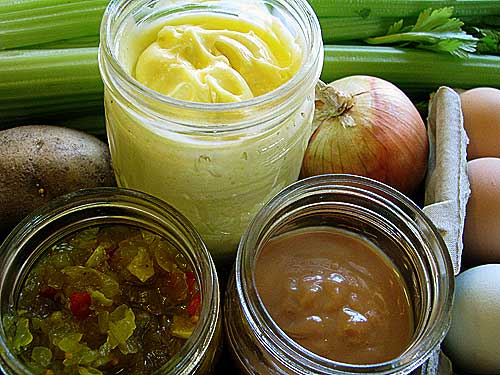Start with a cow.

Tie her up, tie her down, tie her sideways. (Shades of Clover.) Okay, a cow is not quite as much trouble to milk as a goat, but cows are quite strong. Get ‘er milked and take your booty home. I have a post specifically about handling milk here: Handling Milk. I’ll brush by some of that information here, but read that post for more details. I’ve had a number of questions about pasteurizing milk, so this post is going to focus on that process.
I bring my milk home in quart jars transferred from my milking bucket after I finish milking Beulah Petunia down in the meadow bottom. (We’re hoping to have her moved closer to the house soon.)

I open all the jars and get ready to filter and measure the milk.

You can buy milk filters made specifically for this purpose at feed or farm supply stores. No doubt back in the day, they used a couple layers of cheesecloth. Or an old shirt. (I’M JUST KIDDING. Maybe.)

This is what the filters look like.

I use a strainer and a two-quart bowl so I’m measuring as I’m filtering. (You don’t have to measure, of course. I just like to keep track.)

Place a filter in the strainer.

Pour the milk through the filtered strainer into the bowl.

Pour the fresh, clean milk into a big pot.

Stick a thermometer in there.

Put the lid on, as you can around the thermometer.

Turn the heat on medium to medium-low. You can pasteurize by different temperatures. You can pasteurize at 145-degrees and hold the milk at that temperature for 30 minutes. Or you can pasteurize at 165-degrees and hold the milk at that temperature for just 15 seconds.
Pasteurization itself is a hot topic. For many people, there is no milk like raw milk. It can be anything from a taste and nutritional decision to a philosophical and nigh on political position. For others, safety is a weighty concern.
Here are a few of the facts.
Pasteurization was developed as a public health measure to save lives. Heating milk to pasteurize destroys pathogenic bacteria. On the other hand, heating milk to pasteurize also makes proteins, vitamins, and milk sugars less available and destroys enzymes. Pasteurization changes the flavor of milk and denatures the whey proteins, resulting in a weaker curd for cheesemaking. (This is why bacterial starters are commonly used in making cheese.) Ultra-pasteurization involves heating the milk to 191-degrees and is a growing practice that allows a longer shelf life. (Avoid buying ultra-pasteurized milk or cream for any of your cheesemaking endeavors.)
The decision to pasteurize or not pasteurize is a personal one, and I’m barely touching the surface here. Only you can decide what is right for you and your family. Consult expert sources for more information. I didn’t pasteurize my goat milk when I was milking Clover. I knew Clover, knew her history, knew where she came from. I just met Beulah Petunia. I don’t know very much about her, her health history, or the people we got her from. At this time, I’m pasteurizing her milk.
While I’m pasteurizing, I attend to other tasks, such as filling the dishwasher from the mess I just made.

All the jars and bowls, the strainer, my milking pot and other things go straight in the dishwasher to get ready for tomorrow. I’ve got cheese ready to come out the press.

I take it out of the press and set it on a plate inside a cabinet to safely (away from cats!) air dry for a few days before being waxed and aged. It’s a stirred-curd white cheddar, a hard cheese, and will have to age for at least two months.

I take out bowls of milk from the fridge from yesterday’s milking and pasteurizing. Time to take the cream off.

I remove the heavy cream, then the light cream, transferring them to separate containers for later use. Then I pour the milk that remains into pitchers to store for drinking, baking, and cheesemaking.

I take out the milk from two days before and think about what I’m going to make with it.

By then, the milk is finished pasteurizing. I plug the sink then run cold water in it and add ice cubes.

Add the pot to the sink to cool the milk down fast.

Transfer to bowls after about 20 minutes and place the milk in the refrigerator to continue chilling.
Now go make some cheese or something and go on with your life.

That’s just another morning with Beulah Petunia!
Check out all my cheesemaking posts.


















